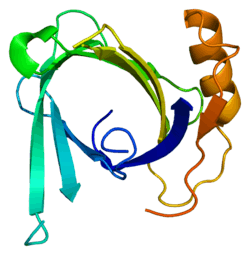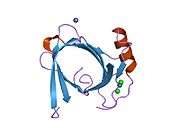Lipocalin 1
Lipocalin-1 is a protein that in humans is encoded by the LCN1 gene.[3][4]
| LCN1 | |||||||||||||||||||||||||
|---|---|---|---|---|---|---|---|---|---|---|---|---|---|---|---|---|---|---|---|---|---|---|---|---|---|
 | |||||||||||||||||||||||||
| |||||||||||||||||||||||||
| Identifiers | |||||||||||||||||||||||||
| Aliases | LCN1, PMFA, TLC, TP, VEGP, lipocalin 1 | ||||||||||||||||||||||||
| External IDs | OMIM: 151675 HomoloGene: 48099 GeneCards: LCN1 | ||||||||||||||||||||||||
| |||||||||||||||||||||||||
| |||||||||||||||||||||||||
| Orthologs | |||||||||||||||||||||||||
| Species | Human | Mouse | |||||||||||||||||||||||
| Entrez |
| ||||||||||||||||||||||||
| Ensembl |
| ||||||||||||||||||||||||
| UniProt |
| ||||||||||||||||||||||||
| RefSeq (mRNA) |
| ||||||||||||||||||||||||
| RefSeq (protein) |
|
| |||||||||||||||||||||||
| Location (UCSC) | Chr 9: 135.52 – 135.53 Mb | n/a | |||||||||||||||||||||||
| PubMed search | [2] | n/a | |||||||||||||||||||||||
| Wikidata | |||||||||||||||||||||||||
| |||||||||||||||||||||||||
The protein encoded by this gene belongs to the lipocalin family. Lipocalins are a group of extracellular proteins that are able to bind lipophiles by enclosure within their structures to minimize solvent contact. This protein may bind hydrophobic ligands and inhibit cysteine proteinases. It may also play a role in taste reception.[4]
References
- GRCh38: Ensembl release 89: ENSG00000160349 - Ensembl, May 2017
- "Human PubMed Reference:". National Center for Biotechnology Information, U.S. National Library of Medicine.
- Lassagne H, Ressot C, Mattei MG, Gachon AM (Feb 1994). "Assignment of the human tear lipocalin gene (LCN1) to 9q34 by in situ hybridization". Genomics. 18 (1): 160–1. doi:10.1006/geno.1993.1444. PMID 8276406.
- "Entrez Gene: LCN1 lipocalin 1 (tear prealbumin)".
Further reading
- Glasgow BJ, Abduragimov AR, Gasymov OK, Yusifov TN (2003). "Tear lipocalin: structure, function and molecular mechanisms of action". Adv. Exp. Med. Biol. 506 (Pt A): 555–65. doi:10.1007/978-1-4615-0717-8_78. PMID 12613960.
- Redl B, Holzfeind P, Lottspeich F (1992). "cDNA cloning and sequencing reveals human tear prealbumin to be a member of the lipophilic-ligand carrier protein superfamily". J. Biol. Chem. 267 (28): 20282–7. PMID 1400345.
- Lassagne H, Nguyen VC, Mattei MG, Gachon AM (1995). "Assignment of LCN1 to human chromosome 9 is confirmed". Cytogenet. Cell Genet. 71 (1): 104–104. doi:10.1159/000134073. PMID 7606920.
- Bläker M, Kock K, Ahlers C, et al. (1993). "Molecular cloning of human von Ebner's gland protein, a member of the lipocalin superfamily highly expressed in lingual salivary glands". Biochim. Biophys. Acta. 1172 (1–2): 131–7. doi:10.1016/0167-4781(93)90279-m. PMID 7679926.
- Holzfeind P, Redl B (1994). "Structural organization of the gene encoding the human lipocalin tear prealbumin and synthesis of the recombinant protein in Escherichia coli". Gene. 139 (2): 177–83. doi:10.1016/0378-1119(94)90752-8. PMID 8112601.
- Lassagne H, Gachon AM (1993). "Cloning of a human lacrimal lipocalin secreted in tears". Exp. Eye Res. 56 (5): 605–9. doi:10.1006/exer.1993.1075. PMID 8500570.
- Holzfeind P, Merschak P, Rogatsch H, et al. (1996). "Expression of the gene for tear lipocalin/von Ebner's gland protein in human prostate". FEBS Lett. 395 (2–3): 95–8. doi:10.1016/0014-5793(96)01008-3. PMID 8898072.
- van't Hof W, Blankenvoorde MF, Veerman EC, Amerongen AV (1997). "The salivary lipocalin von Ebner's gland protein is a cysteine proteinase inhibitor". J. Biol. Chem. 272 (3): 1837–41. doi:10.1074/jbc.272.3.1837. PMID 8999869.
- Redl B, Wojnar P, Ellemunter H, Feichtinger H (1998). "Identification of a lipocalin in mucosal glands of the human tracheobronchial tree and its enhanced secretion in cystic fibrosis". Lab. Invest. 78 (9): 1121–9. PMID 9759656.
- Gasymov OK, Abduragimov AR, Yusifov TN, Glasgow BJ (1999). "Interaction of tear lipocalin with lysozyme and lactoferrin". Biochem. Biophys. Res. Commun. 265 (2): 322–5. doi:10.1006/bbrc.1999.1668. PMID 10558865.
- Wojnar P, Lechner M, Merschak P, Redl B (2001). "Molecular cloning of a novel lipocalin-1 interacting human cell membrane receptor using phage display". J. Biol. Chem. 276 (23): 20206–12. doi:10.1074/jbc.M101762200. PMID 11287427.
- Wojnar P, van't Hof W, Merschak P, et al. (2002). "The N-terminal part of recombinant human tear lipocalin/von Ebner's gland protein confers cysteine proteinase inhibition depending on the presence of the entire cystatin-like sequence motifs". Biol. Chem. 382 (10): 1515–20. doi:10.1515/BC.2001.186. PMID 11727836.
- Wojnar P, Dirnhofer S, Ladurner P, et al. (2002). "Human lipocalin-1, a physiological scavenger of lipophilic compounds, is produced by corticotrophs of the pituitary gland". J. Histochem. Cytochem. 50 (3): 433–5. doi:10.1177/002215540205000314. PMID 11850445.
- Strausberg RL, Feingold EA, Grouse LH, et al. (2003). "Generation and initial analysis of more than 15,000 full-length human and mouse cDNA sequences". Proc. Natl. Acad. Sci. U.S.A. 99 (26): 16899–903. doi:10.1073/pnas.242603899. PMC 139241. PMID 12477932.
- Wojnar P, Lechner M, Redl B (2003). "Antisense down-regulation of lipocalin-interacting membrane receptor expression inhibits cellular internalization of lipocalin-1 in human NT2 cells". J. Biol. Chem. 278 (18): 16209–15. doi:10.1074/jbc.M210922200. PMID 12591932.
- Glasgow BJ, Abduragimov AR, Gassymov OK, et al. (2003). "Vitamin E associated with the lipocalin fraction of human tears". Adv. Exp. Med. Biol. 506 (Pt A): 567–72. doi:10.1007/978-1-4615-0717-8_79. PMID 12613961.
- Tiffany JM, Nagyová B (2003). "The role of lipocalin in determining the physical properties of tears". Adv. Exp. Med. Biol. 506 (Pt A): 581–5. doi:10.1007/978-1-4615-0717-8_81. PMID 12613963.
- Gasymov OK, Abduragimov AR, Yusifov TN, Glasgow BJ (2004). "Interstrand loops CD and EF act as pH-dependent gates to regulate fatty acid ligand binding in tear lipocalin". Biochemistry. 43 (40): 12894–904. doi:10.1021/bi049076o. PMID 15461462.
This article is issued from Wikipedia. The text is licensed under Creative Commons - Attribution - Sharealike. Additional terms may apply for the media files.


